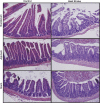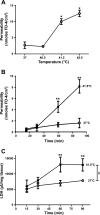Hyperthermia induces injury to the intestinal mucosa in the mouse: evidence for an oxidative stress mechanism
- PMID: 22237593
- PMCID: PMC3330770
- DOI: 10.1152/ajpregu.00595.2011
Hyperthermia induces injury to the intestinal mucosa in the mouse: evidence for an oxidative stress mechanism
Abstract
Loss of the intestinal barrier is critical to the clinical course of heat illness, but the underlying mechanisms are still poorly understood. We tested the hypothesis that conditions characteristic of mild heatstroke in mice are associated with injury to the epithelial lining of the intestinal tract and comprise a critical component of barrier dysfunction. Anesthetized mice were gavaged with 4 kDa FITC-dextran (FD-4) and exposed to increasing core temperatures, briefly reaching 42.4°C, followed by 30 min recovery. Arterial samples were collected to measure FD-4 concentration in plasma (in vivo gastrointestinal permeability). The small intestines were then removed to measure histological evidence of injury. Hyperthermia resulted in a ≈2.5-fold elevation in plasma FD-4 and was always associated with significant histological evidence of injury to the epithelial lining compared with matched controls, particularly in the duodenum. When isolated intestinal segments from control animals were exposed to ≥41.5°C, marked increases in permeability were observed within 60 min. These changes were associated with release of lactate dehydrogenase, evidence of protein oxidation via carbonyl formation and histological damage. Coincubation with N-acetylcysteine protected in vitro permeability during hyperthermia and reduced histological damage and protein oxidation. Chelation of intracellular Ca(2+) to block tight junction opening during 41.5°C exposure failed to reduce the permeability of in vitro segments. The results demonstrate that hyperthermia exposure in mouse intestine, at temperatures at or below those necessary to induce mild heatstroke, cause rapid and substantial injury to the intestinal lining that may be attributed, in part, to oxidative stress.
Figures







Similar articles
-
Protection of intestinal injury during heat stroke in mice by interleukin-6 pretreatment.J Physiol. 2015 Feb 1;593(3):739-52; discussion 753. doi: 10.1113/jphysiol.2014.283416. Epub 2015 Jan 2. J Physiol. 2015. PMID: 25433073 Free PMC article.
-
Regional susceptibility to stress-induced intestinal injury in the mouse.Am J Physiol Gastrointest Liver Physiol. 2013 Sep 15;305(6):G418-26. doi: 10.1152/ajpgi.00166.2013. Epub 2013 Jul 18. Am J Physiol Gastrointest Liver Physiol. 2013. PMID: 23868412
-
Selected contribution: Hyperthermia-induced intestinal permeability and the role of oxidative and nitrosative stress.J Appl Physiol (1985). 2002 Apr;92(4):1750-61; discussion 1749. doi: 10.1152/japplphysiol.00787.2001. J Appl Physiol (1985). 2002. PMID: 11896046
-
Dose titration of FITC-D for optimal measurement of enteric inflammation in broiler chicks.Poult Sci. 2015 Jun;94(6):1353-9. doi: 10.3382/ps/pev111. Epub 2015 Apr 15. Poult Sci. 2015. PMID: 25877413
-
Influence of Heat Stress on Intestinal Epithelial Barrier Function, Tight Junction Protein, and Immune and Reproductive Physiology.Biomed Res Int. 2022 Sep 1;2022:8547379. doi: 10.1155/2022/8547379. eCollection 2022. Biomed Res Int. 2022. PMID: 36093404 Free PMC article. Review.
Cited by
-
Protection of intestinal injury during heat stroke in mice by interleukin-6 pretreatment.J Physiol. 2015 Feb 1;593(3):739-52; discussion 753. doi: 10.1113/jphysiol.2014.283416. Epub 2015 Jan 2. J Physiol. 2015. PMID: 25433073 Free PMC article.
-
Activated leucocyte cell adhesion molecule (ALCAM/CD166) regulates T cell responses in a murine model of food allergy.Clin Exp Immunol. 2018 May;192(2):151-164. doi: 10.1111/cei.13104. Epub 2018 Feb 20. Clin Exp Immunol. 2018. PMID: 29363753 Free PMC article.
-
Effects of Selenium as a Dietary Source on Performance, Inflammation, Cell Damage, and Reproduction of Livestock Induced by Heat Stress: A Review.Front Immunol. 2022 Jan 18;12:820853. doi: 10.3389/fimmu.2021.820853. eCollection 2021. Front Immunol. 2022. PMID: 35116042 Free PMC article. Review.
-
Design of Antioxidant Nanoparticle, which Selectively Locates and Scavenges Reactive Oxygen Species in the Gastrointestinal Tract, Increasing The Running Time of Mice.Adv Sci (Weinh). 2023 Sep;10(27):e2301159. doi: 10.1002/advs.202301159. Epub 2023 Aug 1. Adv Sci (Weinh). 2023. PMID: 37526346 Free PMC article.
-
When heat casts a spell on the DNA damage checkpoints.Open Biol. 2014 Mar 12;4(3):140008. doi: 10.1098/rsob.140008. Open Biol. 2014. PMID: 24621867 Free PMC article. Review.
References
-
- Allen A, Flemstrom G, Garner A, Kivilaakso E. Gastroduodenal mucosal protection. Physiol Rev 73: 823–857, 1993 - PubMed
-
- Blikslager AT, Moeser AJ, Gookin JL, Jones SL, Odle J. Restoration of barrier function in injured intestinal mucosa. Physiol Rev 87: 545–564, 2007 - PubMed
-
- Bouchama A, Knochel JP. Heat stroke. N Engl J Med 346: 1978–1988, 2002 - PubMed
-
- Bouchama A, Ollivier V, Roberts G, Al Mohanna F, de Prost D, Eldali A, Saussereau E, El-Sayed R, Chollet-Martin S. Experimental heatstroke in baboon: analysis of the systemic inflammatory response. Shock 24: 332–335, 2005 - PubMed
Publication types
MeSH terms
Substances
Grants and funding
LinkOut - more resources
Full Text Sources
Medical
Miscellaneous

